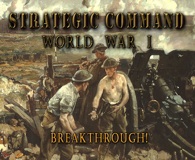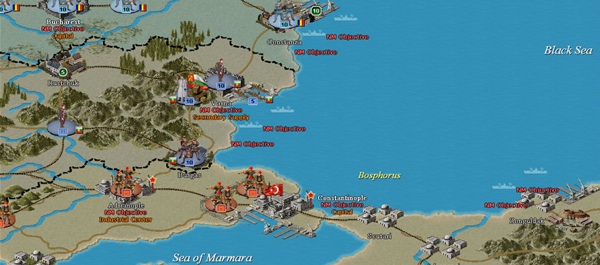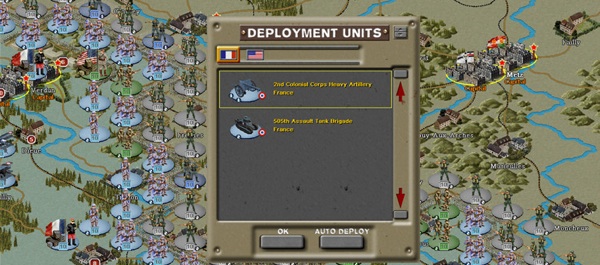Strategic Command World War I: Breakthrough! – PC Game Beta Preview
 Strategic Command World War I – Breakthrough! PC game beta preview. Publisher: Battlefront.com. Developer: Fury Software.
Strategic Command World War I – Breakthrough! PC game beta preview. Publisher: Battlefront.com. Developer: Fury Software.
This expansion to Strategic Command World War I The Great War does more than smooth out rough edges and add a bit of chrome. Hubert Cater and colleagues search out the dusty corners of the Great War to provide a panorama of the extremely varied texture of the conflict. A beta version shows some very interesting but relatively unknown clashes.
The base mechanics of "shoot-move or move-shoot" remain untouched with command and control, unit type and experience being key. Supply rules have been tightened and the War Map allows more insight into strategic possibilities. Military production points are the coin of the realm for new units, replacements and diplomacy. Holding objective tiles and lowering enemy national morale yield victory. The scale for unit and tile size is calibrated to the specific campaign as, is turn length. New units include armored trains, and a new deployment phase in some campaigns lets players place select units themselves on the main map.
{default}Changes to the Big Picture
Of the twenty campaigns, four cover the entire war. "Call to Arms" is a re-make of the original campaign game with two very important changes: players can independently deploy several powerful units and British entry into the war is dependent on the German attitude toward Belgium and is not automatic. "Ostaufmarsch" allow players to reverse the Schiefflen Plan and mass German troops initially against Russia. "France’s Struggle" covers the Western Front at a corps level; "Russia’s War" does the same thing for the East until 1918 or the Revolution. The "Russian Revolution" lasts almost as long as the World War, stretching from November 1918 to September 1922.
All of the larger campaigns require something more than land combat. Blockades must be imposed or broken; convoys should be attacked. Research into advanced weapons and tactics via the expenditure of military production points is essential—the war will be won not just by the soldiers but by the "boffins" with their slide rules and theorems as well. These production points can also be used to apply diplomatic pressure for urging neutrals to take a side, or they can be expended to buy new units or build battered ones back to strength. The latter forces a choice: Reinforcement of existing units lowers their experience level, while new units are at full strength but lack experience.

In terms of strategy, players must watch national morale. A cautious approach may create a slow but steady decline while an adventurous attack may pay dividends but risks a disaster that will tumble morale. Throughout the game, automatic events and decision points will figure into players’ approaches.
Small but Significant
The other sixteen campaigns are smaller but delve into very interesting aspects of the war. A prologue to the main event is seen in "First Balkan War" (1912—1913) with the small nations of the Balkan League ganging up on the apparently moribund Ottoman Empire. However, the "Sick Man" has enough kick left in him to make the campaign interesting. The smaller-scale campaigns of the Great War begin with the "March on Paris," portraying the early months on the Western Front at divisional level. This campaign is bookended by the "Ludendorff Offensive" which shows the divisional operations of the spring and summer of 1918. Paul von Lettow-Vorbeck takes a well-deserved bow in "East Africa" with his two-year campaign of using small detachments in a guerilla war. The importance of keeping a German ship on Lake Tanganyika makes one look around for Humphrey Bogart and Katherine Hepburn.

For those players who like to pit their heads against brick walls, "Verdun" offers a chance to see both France and Germany bled white over a few square miles while the "Nivelle Offensive" depicts the ill-planed attack along the Chemin des Dames that drove the French army to mutiny in 1917. "The Somme" is full of ghastly memories for the British, yet some British units had success that day, giving players a chance at a real breakthrough.
For the more free-wheeling, the "Brusilov Offensive" has the Russians sweeping through southeastern Europe to almost knock Austro-Hungary out of the war—thereby almost saving the Tsar. In the hypothetical "Breakthrough" scenario, British cavalry is positioned close to the front to exploit gaps "to the green fields beyond." "Tannenberg" has the outnumbered Germans maneuvering against two armies of the Russian juggernaut while "Second Meuse" sees Stosstruppen infiltrate and crumble the Entente lines. The attempt to relieve the besieged British division at "Kut" takes players back to a dusty place in Mesopotamia that gave US troops trouble in the Second Iraq War.

The Americans are not forgotten. "St. Miehel" depicts the first predominately Yank offensive against the boche, with George Patton’s tank brigade rumbling in the background. "Meuse-Argonne" throws the doughboys against entrenched Huns in the last stages of the war.
As a change of pace, naval warfare is shown in "Jutland." In this condensed version of the battle, naval tactics are little-used, but the ambush strategies of both sides can be seen. The folly of building the German High Seas fleet is also evident.

Strategic Command World War I—Breakthrough! is not quite comprehensive. Missing are the Italian campaigns of Caporetto and the Isonzo River. Also, the Japanese operations against the Central Power treaty ports in China and the German island colonies would be interesting. Still, this expansion makes this bundle the most comprehensive World War I computer game yet.
About the Author

Jim Cobb has been playing board wargames since 1961 and computer wargames since 1982. He has been writing incessantly since 1993 to keep his mind off the drivel he dealt with as a bureaucrat. He has published in Wargamers Monthly, Computer Gaming World, Computer Games Magazine, Computer Games Online, CombatSim, Armchair General, Subsim, Strategyzone Online and Gamesquad.

